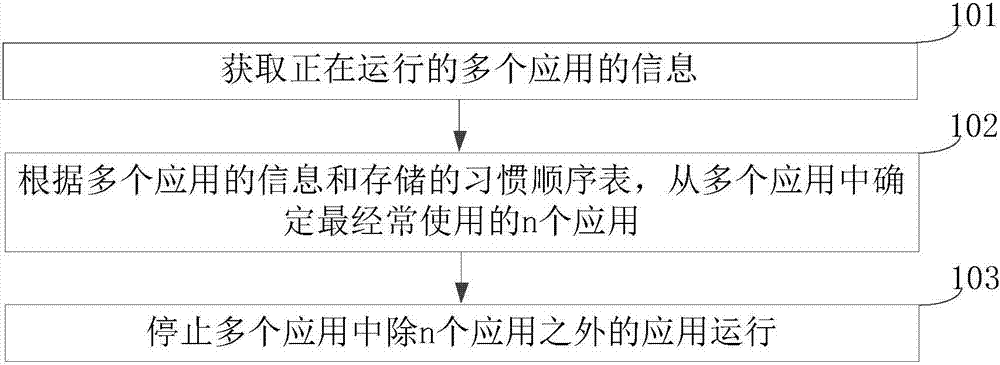Application cleaning method and device
A cleaning method and technology for all applications, applied in the direction of multi-programming devices, electronic digital data processing, program control design, etc., can solve the problems of unsmooth use of terminal equipment, reduce user experience, slow down, etc., and reduce memory utilization , Improve the effect of user experience
- Summary
- Abstract
- Description
- Claims
- Application Information
AI Technical Summary
Problems solved by technology
Method used
Image
Examples
Embodiment 1
[0066] figure 1 is a flow chart of an application cleaning method shown according to an exemplary embodiment, such as figure 1 As shown, the application cleaning method is used in the application cleaning device, including the following steps 101-103:
[0067] In step 101, information about multiple running applications is acquired.
[0068] Here, the information refers to an identifier that distinguishes each application from other applications, for example, an application name. This embodiment is not limited to application names. It is worth explaining that the multiple applications here refer to non-system applications, and the normal operation of the system will not be affected after such applications are stopped.
[0069] In step 102, the most frequently used n applications are determined from the multiple applications according to the information of the multiple applications and the stored habit sequence table.
[0070] Here, the custom order table is the information...
Embodiment 2
[0097] figure 2 is a flow chart of an application cleaning method shown according to an exemplary embodiment, such as figure 2 As shown, the application cleaning method is used in an application cleaning device, the device is applied in a smart phone, and the mobile phone includes multiple applications, including the following steps 201-206:
[0098] In step 201, within a preset time period, the number of operations performed by the user on each application is collected.
[0099] In step 202, the information of all applications is sorted according to the number of operations to obtain the customary order of each application.
[0100] In step 203, the customary sequence of the corresponding information in the customary sequence table is updated with the customary sequence of each application to form a new customary sequence table.
[0101] Here, there is a one-to-one correspondence between the information in the custom sequence table and the custom sequence, and both the in...
Embodiment 3
[0107] image 3 is a flow chart of an application cleaning method shown according to an exemplary embodiment, such as image 3 As shown, the application cleaning method is used in an application cleaning device, the device is applied in a smart phone, and the mobile phone includes multiple applications, including the following steps 301-306:
[0108] In step 301, the mobile phone sends request information for requesting a custom order list to the server.
[0109] In step 302, the server extracts the custom order table of the mobile phone according to the request information.
[0110] Here, the habit sequence table of the mobile phone is stored in the cloud storage of the server.
[0111] In step 303, the server sends the custom sequence list to the mobile phone.
[0112] In step 304, when the screen of the mobile phone is off, the information of multiple running applications is acquired.
[0113] Here, the plurality of applications does not include the first application us...
PUM
 Login to View More
Login to View More Abstract
Description
Claims
Application Information
 Login to View More
Login to View More - R&D
- Intellectual Property
- Life Sciences
- Materials
- Tech Scout
- Unparalleled Data Quality
- Higher Quality Content
- 60% Fewer Hallucinations
Browse by: Latest US Patents, China's latest patents, Technical Efficacy Thesaurus, Application Domain, Technology Topic, Popular Technical Reports.
© 2025 PatSnap. All rights reserved.Legal|Privacy policy|Modern Slavery Act Transparency Statement|Sitemap|About US| Contact US: help@patsnap.com



